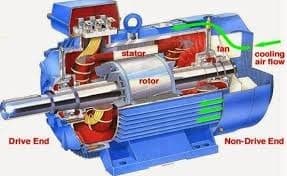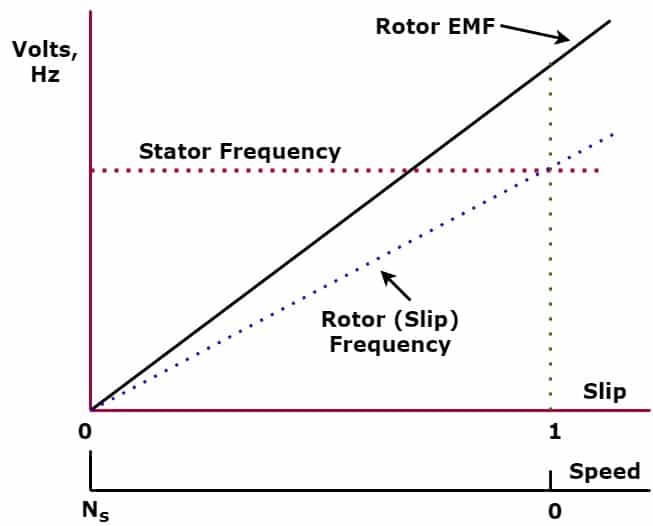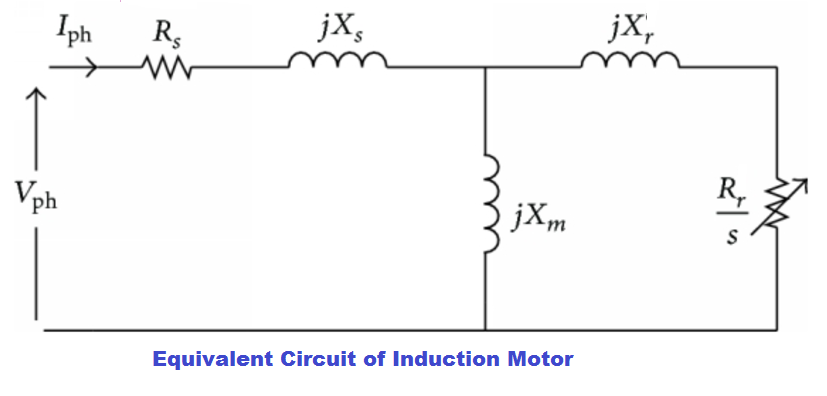Working Principle of Induction Motor:
The induction motor draws a high starting current compared to the running condition. The starting current of the induction motor is about six times the motor’s full-load current. An induction motor rating of 11 KW,22 Amps,440 volts takes a high starting current of about 132 Amps. The current reduces as the motor accelerates toward its base or synchronous speed.
When three three-phase supply is fed to the stator of the induction motor, the motor takes magnetizing current to set up the rotational magnetic flux in the air gap. The flux travels through the air gap, and the short-circuited rotor conductor cuts the magnetic flux. The voltage is induced when the rotor conductor cuts the magnetic flux. The current starts flowing in the rotor conductor. Due to an interaction of the rotor current and the main flux, the torque is produced.

What happens at the start of the motor? The voltage induced in the rotor depends on the relative speed of the synchronous speed of the rotation magnetic field and the speed of the rotor. At the start, the rotor is at a standstill, so its speed is equal to zero. At start, the difference between the speed of the synchronous speed of the rotating magnetic field and the speed of the rotor is maximum. The difference between the synchronous speed and the rotor speed is called the slip of the motor. The slip of the motor is;
s= (Ns- Nr)/Ns *100 ———(1)
Where,
s = Slip
Ns= Synchronous speed of the motor= 120 f/P
Nr = Rotor speed
As the speed of the rotor is zero at the start, the rotor conductor will cut the maximum flux, and the maximum voltage will be induced in the rotor. As the motor starts accelerating, the speed of the rotor will align in the direction of the synchronous speed of the motor, and the slip will reduce. The voltage induced in the rotor conductor can be expressed as;
Er = s* Es ————(2)
Where, Er = Rotor Voltage
s = Slip
Es = Stator Voltage

At the start, the motor’s slip is equal to unity, and the induced rotor voltage is equal to the stator voltage. The rotor-induced voltage decreases as the motor accelerates towards its base speed.
Er = Es When Nr =0 & slip=1
It is clear from the above explanation that the induced rotor is maximum at the start of the motor.
The rotor impedance is highly inductive at the starting time. The rotor inductance is ;
Xr= 2πfrL
Xr = 2π(s*fs)L
The rotor reactance depends on the slip. At the start, the reactance of the rotor is high because the motor’s slip is equal to unity.
The impedance of the rotor circuit is;
Zr=Rr+jsωL
The rotor current is ;
Ir= sEs/(Rr+jsωL)
Ir= Es/(Rr/s+jωL)
The value of Rr/s increases as the slip decreases. When the induction motor is started, the rotor reactance is more than the rotor resistance, and because of the large Xr/Rr ratio, the motor takes a large inductive current. Moreover, because of the large Xr/Rr ratio, the power factor of the motor is very poor. The equivalent circuit of the induction motor is given below.

When the induction motor is switched on, the value of Rr/s is less, and the value of Xr is constant; the value of Rr/s increases as the motor’s slip decreases with an increase in the motor speed. At the start, Xr>Rr/s, and when the motor accelerates, the Rr/s becomes more than the Xr, and the motor current decreases.
From the above discussion, it is clear that at the start, the rotor is highly inductive, and the maximum voltage is induced; hence, the rotor draws a very large current. The current starts to reduce as the motor speeds up because the ratio Rr/s increases with a decrease in the slip with motor acceleration.
many thanks for this information